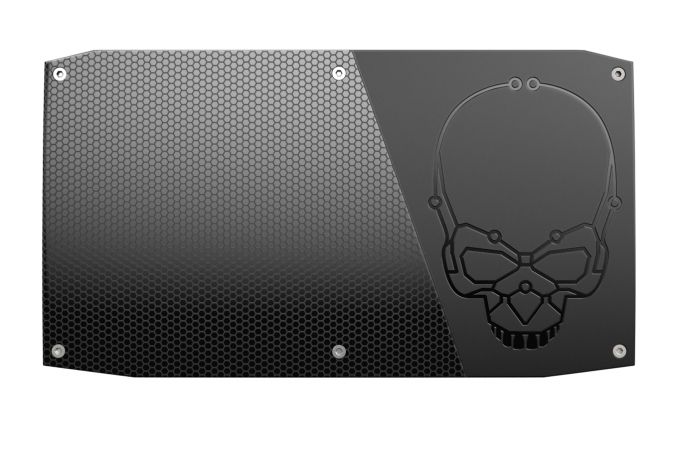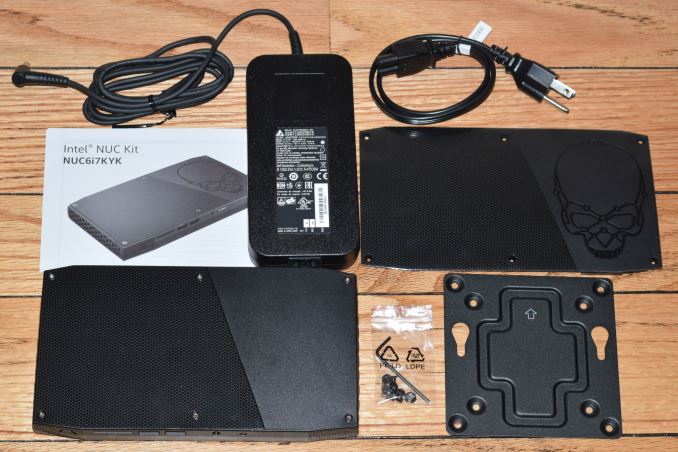The Intel Skull Canyon NUC6i7KYK mini-PC Review
by Ganesh T S on May 23, 2016 8:00 AM EST
The desktop computing market as a whole has been subject to severe challenges over the last few years. The ultra-compact form-factor (UCFF) PC market that emerged with the introduction of the Intel NUCs (Next Unit of Computing) has been one of the few bright spots. PC gaming has been one of the few other markets that has withstood the overall issues. The small size of UCFF PCs usually made discrete GPUs difficult to integrate, and iGPUs have not impressed the gaming crowd. Therefore, the market has not seen many products targeting the gaming market while also being compact. This year, we have a new entrant in that category - Intel's Skull Canyon NUC, the NUC6i7KYK, places a 45W TDP Core i7-6770HQ with Iris Pro graphics in a chassis around twice the size of the standard NUC.
Introduction
In the course of our coverage of mini-PCs, we have seen offerings from vendors such as ASRock, GIGABYTE and Zotac targeting the gaming market. Usually, 'mini' doesn't fit the requirements of consumers in this space, but the appearance of power-efficient high performance GPUs have made the offerings in the gaming mini-PC space quite interesting. The Intel Skull Canyon NUC6i7KYK aims to go one step further by taking the discrete GPU out of the equation and reducing the size of the system as compared to the ASRock VisionX and Zotac ZBOX E-series units.
Skull Canyon has a slightly bigger footprint compared to the traditional NUCs, coming in at 211mm x 116mm x 28mm (compared to the 115mm x 111mm x 32mm of the NUC6i5SYK). Unlike the plain industrial design of the traditional NUC chassis, Skull Canyon goes for slightly more stylish design. The default lid comes with a skull logo on top (Intel's products targeting the gaming market have traditionally included that logo), though the package also includes a lid without the logo. Additional items in the kit include a VESA mount and screws for the same, as well as a 120W (19V @ 6.32A) power brick with a separate power cord. A quick-start manual provides directions on how to add memory and SSDs to the unit.
Intel provided us with an engineering sample of the NUC6i7KYK with DDR4 SODIMMs and a M.2 SSD pre-installed. The specifications of our review unit are summarized in the table below.
| Intel NUC6i7KYK (Skull Canyon) Specifications | |
| Processor | Intel Core i7-6770HQ Skylake-H, 4C/8T, 2.6 GHz (Turbo to 3.5 GHz), 14nm, 6MB L2, 45W TDP |
| Memory | Micron 16ATF1G64HZ-2G1A2 DDR4 15-15-15-36 @ 2133 MHz 2x8 GB |
| Graphics | Intel Iris Pro Graphics 580 |
| Disk Drive(s) | Samsung SSD 950 PRO (512 GB; M.2 Type 2280 PCIe 3.0 x4 NVMe; 40nm; MLC V-NAND) |
| Networking | Intel Dual Band Wireless-AC 8260 (2x2 802.11ac - 866 Mbps) Intel Ethernet Connection I219-LM GbE Adapter |
| Audio | 3.5mm Headphone Jack Capable of 5.1/7.1 digital output with HD audio bitstreaming (HDMI) |
| Miscellaneous I/O Ports | 4x USB 3.0 1x Thunderbolt 3 / USB 3.1 Gen 2 1x SDXC |
| Operating System | Retail unit is barebones, but we installed Windows 10 Pro x64 |
| Pricing (As configured) | $1027 |
| Full Specifications | Intel Skull Canyon NUC6i7KYK Specifications |
The Intel NUC6i7KYK (Skull Canyon) kit doesn't come with any pre-installed OS. Our evaluation was done with Windows 10 Pro x64, with all the latest patches installed. All the drivers, except for the GPU, were downloaded off the Skull Canyon product page. The latest GPU drivers for the Iris Pro Graphics 580 were downloaded from the GPU-specific page. The gallery below shows the various features of the chassis as well as the teardown pictures for lid replacement / memory / SSD installation.
Important aspects to note in the above pictures include the USB 3.0 header visible in the opening beneath the top lid (perfect for third-party lids to take advantage) and the WLAN antennae glued to the top on the front side. It is heartening to see Thunderbolt back after its first and only appearance in the first-generation NUC. The dual M.2 slots are also interesting, and this brings us to the next topic - the board layout.
Platform Analysis and BIOS Features
The NUC6i7KYK uses a Skylake-H CPU in conjunction with the H170 platform controller hub (PCH). The board layout (how the various I/Os communicate with the CPU) is shown below. Of particular interest is the placement of the M.2 slots and the Alpine Ridge Thunderbolt 3 controller.
It is good to see that the SDXC slot is enabled by a PCIe SD card controller (PCIe x1), and not via a USB 2.0 bridge. Intel specifies support for UHS-I speeds. The two M.2 slots are off the PCH. This is understandable since the SATA links that must be multiplexed with the PCIe lanes are going to come off the PCH and the high-speed I/O lanes are shared.
The disappointing aspect here is that the Alpine Ridge controller hangs off the PCH, and not the CPU. Given that a dGPU can only be attached to the system via the Thunderbolt 3 port, it would have made sense to connect it direct to the CPU. This also means that all the high-speed peripherals that can be attached to the NUC6i7KYK are bottlenecked by the DMI 3.0 link between the CPU and the PCH when it comes to exchanging data with the CPU. In the Skylake-H / H170 setup, this link is effectively PCIe 3.0 x4 in terms of bandwidth.
Moving on to the BIOS features, the gallery below presents some screenshots of Intel's VisualBIOS for the NUC6i7KYK.
The important default setting to note is that the performance mode is set to 'Balanced Enabled'. Other options include 'Low Power Enabled' and 'Max Performance Enabled'. The user interface as well as other settings are quite similar to what we saw in the Skylake NUC review, except that the Skull Canyon BIOS has settings specific to the second M.2 slot and the Thunderbolt port.
In the table below, we have an overview of the various systems that we are comparing the Intel NUC6i7KYK (Skull Canyon) against. Note that they may not belong to the same market segment. The relevant configuration details of the machines are provided so that readers have an understanding of why some benchmark numbers are skewed for or against the Intel NUC6i7KYK (Skull Canyon) when we come to those sections.
| Comparative PC Configurations | ||
| Aspect | Intel NUC6i7KYK (Skull Canyon) | |
| CPU | Intel Core i7-6770HQ | Intel Core i7-6770HQ |
| GPU | Intel Iris Pro Graphics 580 | Intel Iris Pro Graphics 580 |
| RAM | Micron 16ATF1G64HZ-2G1A2 DDR4 15-15-15-36 @ 2133 MHz 2x8 GB |
Micron 16ATF1G64HZ-2G1A2 DDR4 15-15-15-36 @ 2133 MHz 2x8 GB |
| Storage | Samsung SSD 950 PRO (512 GB; M.2 Type 2280 PCIe 3.0 x4 NVMe; 40nm; MLC V-NAND) |
Samsung SSD 950 PRO (512 GB; M.2 Type 2280 PCIe 3.0 x4 NVMe; 40nm; MLC V-NAND) |
| Wi-Fi | Intel Dual Band Wireless-AC 8260 (2x2 802.11ac - 866 Mbps) |
Intel Dual Band Wireless-AC 8260 (2x2 802.11ac - 866 Mbps) |
| Price (in USD, when built) | $1027 | $1027 |
























133 Comments
View All Comments
utferris - Monday, May 23, 2016 - link
This can be better with ECC memory support. I just can not use any machine without ECC for work.ShieTar - Monday, May 23, 2016 - link
But a low-frequency consumer quad-core is fine? What exactly do you do at work?Gigaplex - Tuesday, May 24, 2016 - link
Sometimes reliability is more important than performance.close - Monday, May 23, 2016 - link
Guess ECC is not high on the list for potential NUC buyers, even if it's a Skull Canyon NUC. I think most people would rather go for better graphics than ECC.kgardas - Monday, May 23, 2016 - link
Indeed, the picture shows SO-DIMM ECC, but I highly doubt this is even supported since otherwise it's not Xeon nor Cxxx chipset...close - Tuesday, May 24, 2016 - link
http://ark.intel.com/search/advanced?ECCMemory=tru...tipoo - Monday, May 23, 2016 - link
What work do you want to do on a 45W mobile quad with (albeit high end) integrated graphics, that needs ECC?I wonder how that would work with the eDRAM anyways, the main memory being ECC, but not the eDRAM.
Samus - Monday, May 23, 2016 - link
All of the cache in Intel CPU's is ECC anyway. Chances of errors not being corrected by bad information pulled from system RAM is rare (16e^64) in consumer applications.ECC was more important when there was a small amount of system RAM, but these days with the amount of RAM available, ECC is not only less effective but less necessary.
I'm all for ECC memory in the server/mainframe space but for this application it is certainly an odd request. This is, for the most part, a laptop without a screen.
TeXWiller - Tuesday, May 24, 2016 - link
>ECC was more important when there was a small amount of system RAM,The larger the array the larger target it is for the radiation to hit. Laptops are often being used in high altitude environments with generally less shielding than the typical desktop or even a server so from that perspective ECC would seem beneficial basic feature. Then there are the supercomputers, a fun read: http://spectrum.ieee.org/computing/hardware/how-to...
BurntMyBacon - Tuesday, May 24, 2016 - link
@TeXWiller: "The larger the array the larger target it is for the radiation to hit."While this is true, transistor density has improved to the point that, despite having magnitudes more capacity, the physical array size is actually smaller. Of course the transistors are also more susceptible given the radiant energy is, relatively speaking, much greater compared to the energy in the transistor than it was when transistors were larger. There is also the consideration that as transistor density increases, it becomes less likely that radiation will strike the silicon (or other substrate), but miss the transistor. So we've marginally decreased the chance that radiation will hit the substrate, but significantly increased the change that any hit that does occur will be meaningful.